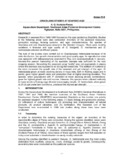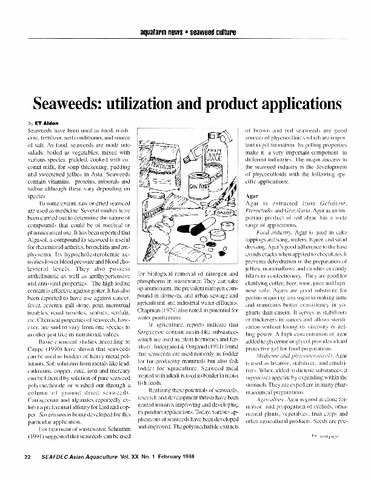| dc.contributor.author | Bautista-Teruel, Myrna N. | |
| dc.contributor.author | de la Peña, Milagros R. | |
| dc.contributor.author | Asutilla, Analyn J. | |
| dc.date.accessioned | 2015-05-19T03:50:30Z | |
| dc.date.available | 2015-05-19T03:50:30Z | |
| dc.date.issued | 2013 | |
| dc.identifier.citation | Bautista-Teruel, M. N., de la Peña, M. R., & Asutilla, A. J. (2013). Evaluation of agar-bound microparticulate diet as alternative food in abalone hatchery: Effects of agar concentrations and feeding frequencies. Journal of Shellfish Research, 32(1), 9-15. | en |
| dc.identifier.issn | 0730-8000 | |
| dc.identifier.uri | http://hdl.handle.net/10862/2231 | |
| dc.description.abstract | The performance of an agar-bound microparticulate diet (A-MPD) was evaluated on feeding postlarval abalone Haliotis asinina, focusing on the effects of agar concentrations and feeding frequencies. Larval abalone, obtained from the Southeast Asian Fisheries Development Center, Aquaculture Department hatchery, were reared in 60-L flow-through tanks with UV-filtered seawater. They were fed 1,200 mg A-MPD bound with either 5.0 mg/mL agar solution, 7.5 mg/mL agar solution, 10.0 mg/mL agar solution, and 12.5 mg/mL agar solution, or a natural diet consisting of diatoms at different feeding frequencies (daily, every other day, or every 2 d) starting at day 5. A 5 × 3 factorial experiment in a completely randomized design tested the effects of various treatments on postlarval settlement and survival after days 15 and 90. Scheffé's postcomparison test determined differences among treatments means. Postlarval settlement and survival were not significantly different in diets bound with higher agar concentrations and tested in 3 feeding frequencies. At lower levels of agar incorporation in diets, however, settlement and survival counts became significantly higher on daily feeding. Postlarval settlement and survival were significantly highest with abalone fed a diet bound with 7.5 mg/mL agar solution on a daily feeding frequency. Average percent weight loss in the feed was higher with lower levels of agar incorporation. Average particle size of both A-MPD and diatoms was 4–5 µm. Crude protein content of A-MPD was 42.7%; that of diatoms was 14.9%. A-MPD may be used as alternative food in abalone hatcheries with the incorporation of 7.5 mg/mL agar solution fed daily to abalone. | en |
| dc.language.iso | en | en |
| dc.publisher | National Shellfisheries Association | en |
| dc.subject | Haliotis | en |
| dc.subject | Haliotis asinina | en |
| dc.subject | weight losses | en |
| dc.title | Evaluation of agar-bound microparticulate diet as alternative food in abalone hatchery: Effects of agar concentrations and feeding frequencies | en |
| dc.type | Article | en |
| dc.citation.volume | 32 | |
| dc.citation.issue | 1 | |
| dc.citation.spage | 9 | |
| dc.citation.epage | 15 | |
| dc.citation.journalTitle | Journal of Shellfish Research | en |
| dc.subject.asfa | diet | en |
| dc.subject.asfa | Bacillariophyceae | en |
| dc.subject.asfa | agar | en |
| dc.subject.asfa | biological settlement | en |
| dc.subject.asfa | shellfish culture | en |
| dc.subject.asfa | phytoplankton | en |
| dc.subject.asfa | feeding experiments | en |
| dc.subject.asfa | marine molluscs | en |
| dc.subject.asfa | settling behaviour | en |
| dc.subject.asfa | feed composition | en |
| dc.subject.asfa | particle size | en |
| dc.subject.asfa | feeding | en |
| dc.subject.asfa | food | en |
| dc.subject.asfa | survival | en |
| dc.subject.asfa | aquaculture | en |
| dc.subject.asfa | hatcheries | en |
| dc.subject.asfa | marine environment | en |
| dc.subject.asfa | fisheries | en |
| dc.identifier.doi | 10.2983/035.032.0103 | |



